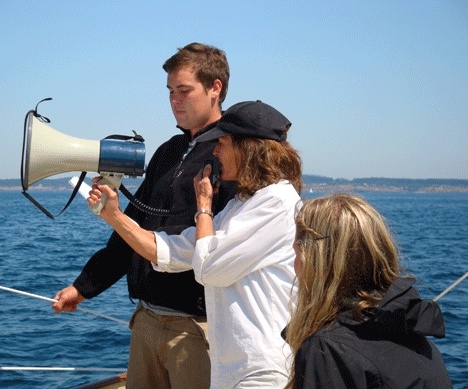Orca Relief Citizens Alliance says more protests are to come, after its initial July 11 on-the-water protest of commercial whale-watching vessels.
The protest began a few miles off San Juan Island’s west side. The group included Isla Cropper, Suzanne Franklin, Adrian Kilpatrick, Peter Kilpatrick, Rowan North, and boat skipper Henry Wendt, past CEO of SmithKlineBeacham.
The protesters approached a number of whale-watch boats and broadcast this message over a bullhorn:
“Attention whale watchers: We are a group of islanders who are concerned that our resident population of orcas is moving toward extinction. They need to be left alone! They need the freedom to hunt without the impact of being pursued all day by the whale watch fleet.
“The pursuit of these whales is a violation of the Endangered Species Act, Section 9, and of the Marine Mammal Protection Act of 1973. You and your customers are violating federal law. You need to stop immediately, and know that by doing so, you are helping to save this group from extinction. If you do not stop immediately, the evidence of your violation will be turned into the National Marine Fisheries Service for prosecution.”
The Southern resident killer whales are listed as endangered by the federal government. State law prohibits boats from approaching within 300 feet of an orca; the penalty is a fine of $1,025. Violation of the Endangered Species Act can yield stiffer federal penalties.
The population of the three Southern resident pods is estimated to be 85 — 26 in J pod, 19 in K pod, 40 in L pod. According to the Center for Whale Research on San Juan Island, threats to the whales include diminished salmon runs, pollution and vessel impacts.
At one time, the combined Southern resident population was believed to be over 120. Fifty whales were captured for marine parks between 1965 and 1973, dropping the population to 71 by 1973. The population rebounded to 99 by 1995, then plummeted to 79 by 2001. The population has seesawed in the mid-80s since then: 80 in 2002, 83 in 2003, 85 in 2004, 89 in 2005-06, 88 in 2007, 87 in 2008, and 85 this year.
Three whales were born in the last 12 months, but six failed to return with their pods, according to the center.
Orca Relief believes noise from whale-watch vessels interferes with the orcas’ echolocation and impairs their ability to hunt.
Orca Relief accuses commercial whale-watch companies of pursuing the whales, employing airplane spotters, land scouts, radio and Internet communications, and high-speed boats to assure their success.
“These companies advertise guaranteed whale sightings, and that means they are pursuing them in order to make their money,” Orca Relief chairman Mark Anderson said in a press release. “This is against federal law, and it is time for this law to be enforced, before we lose what is left of these pods. Imagine the idea of creating a business to pursue an endangered species. It sounds as crazy as it is.”
Anderson added, “People who care about whales should watch them from the land, at the Whale Watch Park.”
Anderson said more protests can be expected. “We are not telegraphing our moves, except to say that we will continue to do actions on the water this season.”
Kari Koski of The Whale Museum’s Soundwatch Boater Education Program disagrees with Orca Relief’s interpretation of “pursuit.”
“Orca Relief is barking up the wrong tree,” said Koski, whose organization educates boaters about responsible behavior in the whales’ presence. “Overall, it is private boaters, not commercial whale-watch boats, that are responsible for the majority of violations.”
The skipper of a Bayliner photographed getting too close to an orca off the west side of San Juan Island in May has been charged with violating orca protection law. Sgt. Russ Mullins of the state Fish and Wildlife Department said it was the fourth such citation issued since 2008, when the state Legislature adopted a law making it illegal to “approach or cause a vessel to approach a southern orca whale within 300 feet.” It is also illegal to “intercept, feed, or fail to disengage the transmission of a vessel within 300 feet of a southern orca whale.”
The three earlier citations were issued last summer for violations committed in Whatcom County, all by private boaters.
Koski argues that the word “pursue,” as intended by the Endangered Species Act, is meant to prevent the “harmful stalking” of an orca, not the act of viewing the animals.
Brian Goodremont, vice president of the Pacific Whale Watch Association, agrees.
“It’s quite clear that the state and federal government don’t see the law that way,” Goodremont said of Orca Relief’s interpretation of the Endangered Species Act.
Goodremont said he has not been contacted by Orca Relief.



